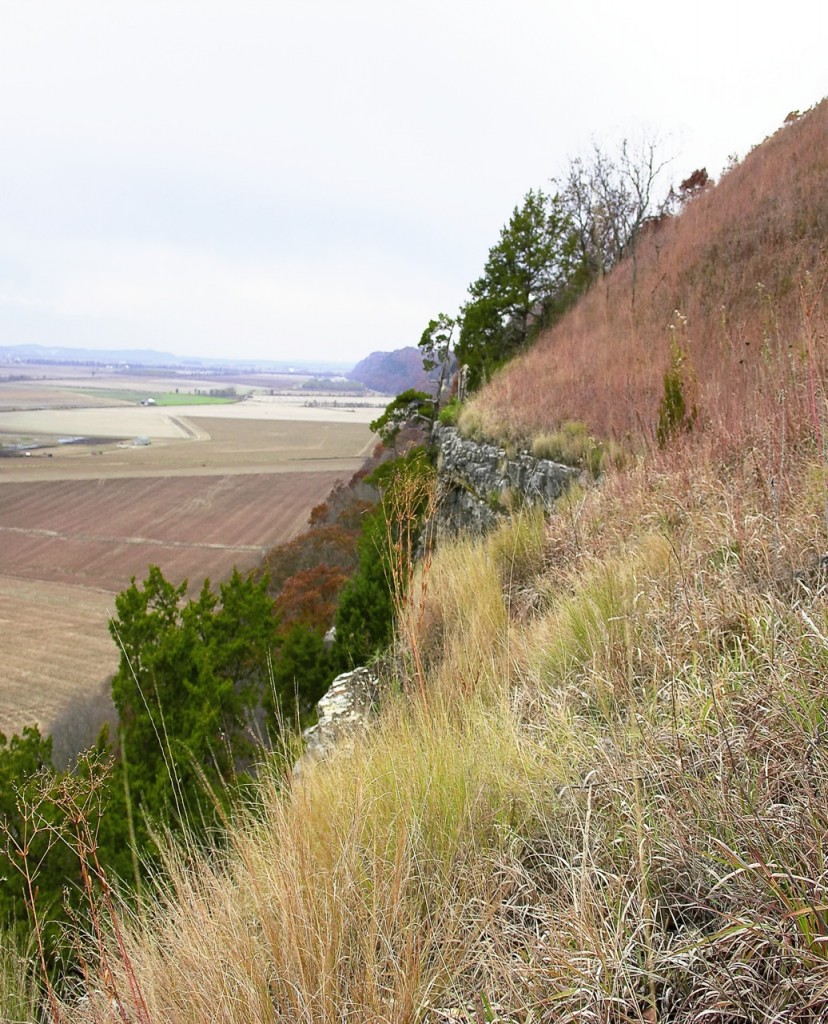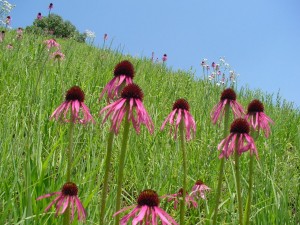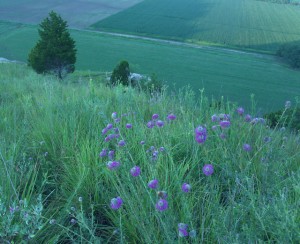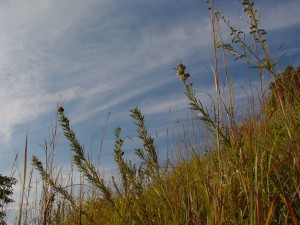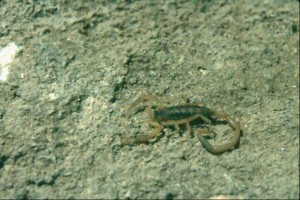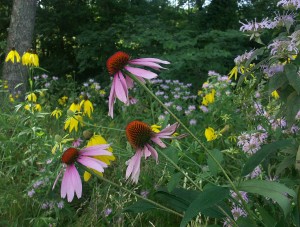Prairie State’s Remaining Prairies Cling to Bluffs
Illinois, the Prairie State, once was part of a vast grassland, covering most of central North America, called the tallgrass prairie. In pre-European settlement times, Illinois consisted of approximately 22 million acres of prairie — about 60 percent of the state’s land — and 14 million acres of forest.
At the time of European settlement, several large tallgrass prairies existed in Monroe and Randolph Counties. Big Prairie, on the American Bottoms, ran for 10 miles in southern St. Clair and northern Monroe Counties. Flat Prairie, some 10 miles in diameter, was located 20 miles east of Kaskaskia in Randolph County. Horse Prairie, also in Randolph County, got is name from the presence of wild horses roaming there. And the grandest, Prairie du Long, a huge 70-square mile tallgrass prairie, stretched from southern St. Clair County through Monroe County’s eastern panhandle into Randolph County.
By 1830, farmers began to realize that tallgrass prairie soils were more fertile than forest soils and much easier to convert to agricultural use. In the years following the Civil War, conversion and cultivation of prairie accelerated. This was due to both the development of railroads, giving farmers improved transportation for their goods, and to the ever-increasing pace of agricultural mechanization. By 1900, most of Illinois’ tallgrass prairie was gone. Today, only one percent of the original sea of grass remains in the state. In an ironic twist the very “sodbuster” pioneers who broke the great prairies for agricultural bounty now protect many of the small remnants, for pioneer cemeteries, untouched by plow and mower, now harbor tallgrass prairies.
Also remaining, however, are variations on tallgrass prairie called hill prairies. Hill prairies are distinctive natural communities occurring along the bluff tops of major rivers in the Midwest. They are island-like small patches of prairie growing on the steep south- and southwest-facing slopes immediately above the cliffs. The hot, windy and dry conditions on the slopes discourage all but the hardiest prairie plants.
The bluff lands of Monroe County historically were completely forested, excepting on the cliff edges and in forest openings, called glades. Today, our bluff lands are home to more hill prairies than any other county in Illinois. Many of the hill prairies can be easily spotted from Bluff Road, clinging to the slopes, from the tree lines to the cliff edges. The hill prairies of Monroe County differ from others in the state because of a unique geologic history.
Pleistocene glaciers that covered most of Illinois — which were responsible for the pancake flatness of most of our state — didn’t quite reach the bluff corridor. Our landscape is really a geographic extension of Missouri’s Ozark Plateau jutting into Illinois. As a result, our hill prairies host some unusual plants and animals, more characteristic of Missouri and the West, and rare or nonexistent elsewhere in Illinois.
Hill prairies are a collage of plants — broad-leaved plants called forbs and grasses — growing close together; sharing and competing for resources. This arms race for resources — for sunlight, soil moisture and nutrients — results in the plants taking turns at growth and flowering. Small, short forbs grow and flower earlier racing ahead of the taller grasses to stay in the sunlight. These earliest growing flowering plants include alumroots, oxalis, whitlow grass, blue-eyed grass, bluets, cleft phlox, and puccoons. They are the first to flower, but are largely dormant by June.
As the summer progresses, so does the height of flowering forbs, continuing to race the heights of the dominant grasses. Next to bloom are several species of coreopsis, spiderworts, fleabanes, bergamot, coneflowers, skullcaps, beardtongue, prickly pear cactus and milkweeds. Then come the legumes:
lead plant, bush clovers, prairie clovers, mountain mints, goat’s rue, scurf pea, and partridge pea. Blazing stars follow. Even as they race the grasses for available sunlight, many of the forbs also lean on and into the grasses which help them stand erect. The forbs return the favor with an abundance of nectar-producing flowers attracting insect pollinators who also visit and pollinate the tiny flowers arranged along the growing tips of the grasses.
By midsummer, three tall grasses dominate the hill prairies: thigh-high side-oats grama, waist-high little bluestem, and head-high Indian grass. As the grasses turn to fall colors, complete setting their seeds, and begin to dry out
and die back, it is time for the “composite” flowers. A dozen species of goldenrods, asters, and boneset come into bloom in late summer, setting their bright colors against the dominate orange and golden-tans of the still-upright dried grasses.
In all, over a hundred species of plants make up our hill prairies. A couple of noteworthy “Ozarkian” rarities are found only here in the entire state. Missouri coneflowers, a certain heliotrope, and a dwarf bedstraw grow only in Monroe and Randolph County hill prairies. Stickleaf can be found only here and in three other counties along the Mississippi. Our hill prairies and glades also host two animal species found only here in all of Illinois.
The stripped or plains scorpion lives only in the hill prairies of Monroe and Randolph Counties. It is Illinois’ only scorpion, and is a far more common resident of the Missouri Ozarks. Scorpions belong to the same family, Arachnida, as spiders, ticks and mites, and, like them, have four pairs of jointed
legs The paired enlarged pincers at their front are used to capture prey; the stinger at the tip of the long tail is used in defense. Even though scorpions may have as many as six pairs of eyes positioned on their backs and along their bodies, they have poor eyesight. The pincers have tiny, very sensitive hairs that help detect motion, and scorpions also have a comb-like structure on their undersides which seems to sense movement including ground vibrations, and also may detect sound. Scorpions are solitary creatures, interacting only to mate or, sometimes, to prey upon each other. Scorpions give birth to live young, which climb onto their mother’s back and remain with her for one to two weeks.
The plains scorpion is about an inch and half-long, and holds its tail to one side, as do all scorpions that remain under stone or bark during the day. They are active only at night, emerging from their shelters to hunt their prey — spiders, cockroaches, ants, beetles and crickets, or, sometimes, a smaller, weaker scorpion. The sting of our native scorpion generally is no worse than a bee or wasp sting, although a few people may have an allergic reaction and experience severe symptoms.
Plains scorpions sometimes are food for another very rare hill prairie, glade, and talus slope resident, the flathead snake. The diminutive, seven-inch long flathead snakes now are only found in Monroe County, although their range once included St. Clair, Randolph and Union Counties. They have brownish-tan bodies, darker brown heads, and salmon-pink bellies. Also nocturnal, flathead snakes live under rocks and logs on rocky wooded hillsides with plentiful limestone. They eat plains scorpions as well as spiders, centipedes and other small insects which they seem to track by scent. Flathead snakes pose no threat to humans but may serve to remind us of the unique nature and specialness of our bluff lands.
Recognizing the singular uniqueness of the hill prairies, the State of Illinois established Fults Hill Prairie Nature Preserve in 1970. Located just south of the Village of Fults along Bluff Road, the 532-acre site contains the largest complex of hill prairies in Illinois. In 1986, the U.S. Department of Interior’s National Park Service designated Fults Hill Prairie a National Natural Landmark. There are only 600 such landmarks in the entire country. Our bluff
lands shelter a little known, one-of-a-kind natural national treasure, in our own backyard.
Clifftop, a local nonprofit organization, is focused on preserving and protecting area bluff lands.
A version of this article appeared in the July 4 2007 edition of the Monroe County Clarion.
© 2007 all content rights reserved, Clifftop NFP.
Comments are currently closed.

